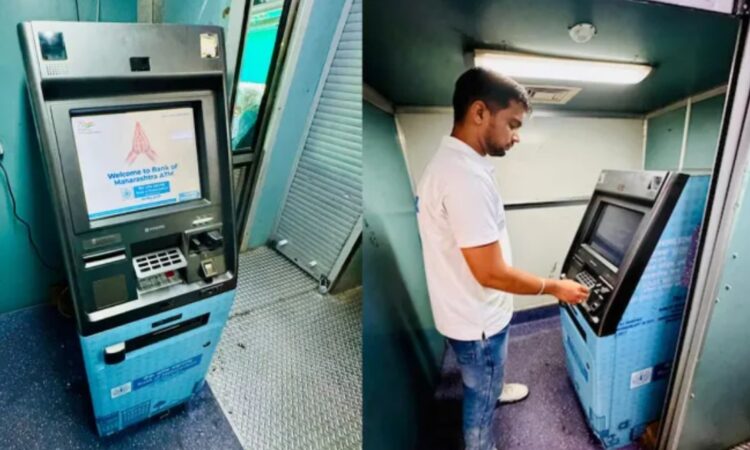KEY POINTS
- Indian Railways installs India’s first moving train ATM on the Secunderabad Express
- Passengers can withdraw cash while the train is in motion
- Initiative launched under ‘One Station, One Product’ scheme
In a historic move, Indian Railways has installed an Automated Teller Machine (ATM) on a train for the first time. This trial began on April 10, 2025, aboard the Manmad-CSMT Panchvati Express in Maharashtra. Union Railway Minister Ashwini Vaishnaw shared a video of this unique ATM on his official X account, calling it a step towards innovation and passenger convenience.
In a first, ATM facility in train. pic.twitter.com/onTHy8lxkd
— Ashwini Vaishnaw (@AshwiniVaishnaw) April 16, 2025
The mini pantry space of the train was transformed into an ATM cabin by the mechanical team. According to officials, the ATM has been securely mounted with rubber pads and bolts to reduce vibrations during travel. For safety, two fire extinguishers have also been installed inside the ATM cabin.
Why an ATM on a Train?
This initiative is part of the Railway Board’s effort to explore new ways to increase non-fare revenue. On March 25, 2025, a meeting was held with several vendors to discuss creative solutions. During this session, the idea of installing mobile ATMs on running trains was proposed.
The “ATM on Wheels” is expected to offer additional services to passengers while also helping the railways earn money through partnerships with banks and service providers.
The installation of an ATM on a train is just one of many steps in Indian Railways’ ambitious plan to transform and modernize itself. Under the Viksit Bharat 2047 vision, Indian Railways has adopted advanced technologies, modern trains, upgraded stations, and better safety features.
By 2024, Indian Railways completed 6,450 km of track renewal, improved speeds up to 130 kmph across 2,000 km, and electrified over 3,210 route km, covering 97% of its broad-gauge network. It also introduced renewable energy capacity of 2,014 MW, showing a commitment to a greener future.
Indian Railways is expanding its fleet with modern trains like Vande Bharat and Amrit Bharat. In 2024 alone, 136 Vande Bharat trains were added, along with the country’s first Namo Bharat Rapid Rail. Special trains were also run during festivals and high-demand periods, with over 21,000 such services launched.
To ensure safety, Indian Railways is equipping 10,000 locomotives with the Kavach system, an indigenous train protection technology. Around 9,000 technicians have been trained for its use, and tenders have been floated to install Kavach over 15,000 km of railway lines.
The railways are not just modernizing passenger trains but also focusing on rolling stock. Rs 45,500 crore was allocated in the Union Budget 2025-26 to improve engines, wagons, and coaches. Manufacturing of Vande Bharat coaches rose from 216 in 2022-23 to 900 in 2024-25, showing a strong commitment to self-reliant development.
The new sleeper version of Vande Bharat, developed by BEML and Medha Servo in partnership with ICF, is undergoing final certification. These trains include modern heating systems to operate smoothly in cold climates, as tested on the Katra-Srinagar route.
Indian Railways is also preparing to roll out 50 Amrit Bharat version 2.0 trains with new features like vacuum toilets, automatic brakes, and on-board monitoring systems by 2027.
To boost freight efficiency, IR introduced the design for Vande Cargo Trains in 2024. These are high-speed parcel trains based on the Vande Bharat platform, expected to run at 160 kmph. Additionally, eight freight trains were successfully joined into four long-haul cargo services between Dadri and Deendayal Upadhyay junction, improving operations on the Eastern Dedicated Freight Corridor.
Also, double-decker cargo liners, based on air cargo concepts, are being developed. Each coach will carry up to 6 tonnes of goods and offer passenger space on the upper deck. These liners are expected to strengthen India’s cargo movement in a modern and efficient way.
India is preparing to launch its first bullet trains, modeled on Japan’s Shinkansen Alfa-X, with speeds of up to 400 kmph. The first Indian-made prototypes are expected to be tested between Ahmedabad and Mumbai by 2027.
Meanwhile, India’s first hydrogen-powered train is being developed with 1,200 horsepower, higher than global standards. It can carry over 2,600 passengers and aims to help Indian Railways reach net-zero carbon emissions by 2030.
In December 2024, India completed its first hyperloop test track (410 meters long) with the help of IIT Madras and TuTr Hyperloop Pvt Ltd. This futuristic technology could transport passengers at speeds of 600 kmph inside vacuum tubes.
Indian Railways is focusing on domestic production of components to reduce dependence on imports. A new coach manufacturing facility is under construction in Kazipet, Telangana, with capacity to make 600 coaches and locomotives annually. Completion is expected by August 2025.
Also, two aerodynamic WAP-5 electric locomotives were launched from Chittaranjan Locomotive Works in October 2024. These are designed for Amrit Bharat trains and feature advanced safety and monitoring systems.
Major global companies are now investing in Indian Railways. In January 2025, Alstom received a Rs 1,300 crore contract to supply electrical parts for Vande Bharat sleeper trains. Similarly, Russia’s Transmashholding (TMH) is investing in manufacturing facilities across India to support the Make in India initiative.
The Road Ahead
By 2027-28, Indian Railways plans to launch:
- 200 Vande Bharat trains
- 100 Amrit Bharat trains
- 17,500 general coaches
- 50 hydrogen trains by 2047
A 7,000 km high-speed rail corridor is also being developed, aimed at supporting trains running at speeds of 250 kmph by 2047.
From installing ATMs on trains to planning bullet and hydrogen-powered trains, Indian Railways is moving swiftly on the track of progress. Every new initiative, whether it’s smart freight systems, renewable energy, or advanced passenger safety, shows that India is committed to building a world-class railway network that serves its people and drives national growth.

















Comments